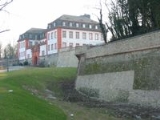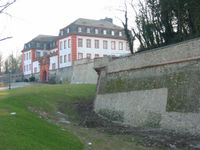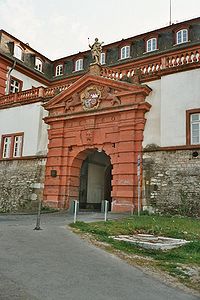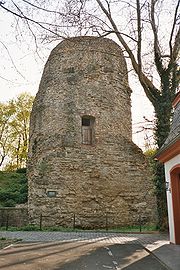
Zitadelle Mainz
Encyclopedia
 |
 |
 |
The Mainzer Zitadelle (Citadel of Mainz
Mainz
Mainz under the Holy Roman Empire, and previously was a Roman fort city which commanded the west bank of the Rhine and formed part of the northernmost frontier of the Roman Empire...
) is situated at the fringe of the Old Town near Mainz Römisches Theater station
Mainz Römisches Theater station
Mainz Römisches Theater station is a station in the city of Mainz, the capital of the German state of Rhineland-Palatinate on the Main Railway from Mainz to Frankfurt am Main. It is the most important station in the city after Mainz Hauptbahnhof. It is classified by Deutsche Bahn as a category 3...
. The fortress was constructed in 1660 and was an important part of the Fortress Mainz
Fortress Mainz
The Fortress of Mainz was a fortressed garrison town between 1620 and 1918. At the end of the Napoleonic Wars, under the term of the 1815 Peace of Paris, the control of Mainz passed to the German Confederation and became part of a chain of strategic fortresses which protected the Confederation with...
.
History
The Jakobsberg hill, where the citadel was constructed, had been occupied by a BenedictineBenedictine
Benedictine refers to the spirituality and consecrated life in accordance with the Rule of St Benedict, written by Benedict of Nursia in the sixth century for the cenobitic communities he founded in central Italy. The most notable of these is Monte Cassino, the first monastery founded by Benedict...
abbey
Abbey
An abbey is a Catholic monastery or convent, under the authority of an Abbot or an Abbess, who serves as the spiritual father or mother of the community.The term can also refer to an establishment which has long ceased to function as an abbey,...
during the middle ages
Middle Ages
The Middle Ages is a periodization of European history from the 5th century to the 15th century. The Middle Ages follows the fall of the Western Roman Empire in 476 and precedes the Early Modern Era. It is the middle period of a three-period division of Western history: Classic, Medieval and Modern...
(since 1050). Halfway up the hill, the amphitheater
Roman theatre (structure)
The characteristics of Roman to those of the earlier Greek theatres due in large part to its influence on the Roman triumvir Gnaeus Pompeius Magnus. Much of the architectural influence on the Romans came from the Greeks, and theatre structural design was no different from other buildings...
of the Roman settlement of Mogontiacum, which has been recently excavated, must also have been visible at that time. The Jakobsberg hill, however, had not been integrated in the ring of the defensive city walls of the town and this flank of the city was therefore only slightly protected. This position immediately at the gates of the town opened a strategic gap, as an aggressor could use the hill for a raid into Mainz or for a cannonade. The construction of the "Schweickhardtsburg" fortress under the supervision of cathedral vicar
Vicar
In the broadest sense, a vicar is a representative, deputy or substitute; anyone acting "in the person of" or agent for a superior . In this sense, the title is comparable to lieutenant...
Adolph von Waldenburg during the years 1620-29 provisionally filled this gap and integrated the hill into the system of city walls. The name of the irregularly pentagonal fortification honors the reigning monarch of that time, the prince-elector
Prince-elector
The Prince-electors of the Holy Roman Empire were the members of the electoral college of the Holy Roman Empire, having the function of electing the Roman king or, from the middle of the 16th century onwards, directly the Holy Roman Emperor.The heir-apparent to a prince-elector was known as an...
Johann Schweikhard von Kronberg
Johann Schweikhard von Kronberg
Johann Schweikhard von Kronberg was the Archbishop-Elector of Mainz from 1604 to 1626.-Early Life, 1553-1604:Born on July 15, 1553, Johann Schweikhard von Kronberg was the third son of Hartmut XIII von Kronburg and his wife Barbara von Sickingen...
.
Around 1655 prince-elector Johann Philipp von Schönborn
Johann Philipp von Schönborn
Johann Philipp von Schönborn was the Archbishop-Elector of Mainz from 1647 until 1673, the Bishop of Würzburg from 1642 until 1673, and the Bishop of Worms from 1663 until 1673....
initiated an improvement of the fortification of the entire town comprising bastion
Bastion
A bastion, or a bulwark, is a structure projecting outward from the main enclosure of a fortification, situated in both corners of a straight wall , facilitating active defence against assaulting troops...
s according to French type. Within this modification of the fortress, the Schweickhardtsburg was converted into the regular, quadrangular citadel, as it is today. St. Jacobs abbey and the Roman cenotaph
Cenotaph
A cenotaph is an "empty tomb" or a monument erected in honour of a person or group of people whose remains are elsewhere. It can also be the initial tomb for a person who has since been interred elsewhere. The word derives from the Greek κενοτάφιον = kenotaphion...
, the Drususstein
Drususstein
The Drususstein is a nearly 20 meters high, masonry block of Roman origin on the grounds of the citadel of Mainz. It was originally cast in marble...
, remained untouched within the fortress.
Above the gate in direction to the town, a building for the commander of the citadel was erected in 1696 by the order of Lothar Franz von Schönborn
Lothar Franz von Schönborn
Lothar Franz von Schönborn was the Archbishop-Elector of Mainz from 1694 until 1729, and the Bishop of Bamberg from 1693 until 1729.Lothar Franz was born in Steinheim am Main in 1655 to Count Philip Erwin of Schönborn...
. The gateway, existing since 1660 was skillfully integrated in the new building.
During the siege of Mainz (1793) St. Jacobs abbey was destroyed largely by Prussian shelling. The remainings of the abbots and guest house had been used only for military purposes since then. In the south of the courtyard a baroque garden existed, which can be seen on a map dated 1804.
After the Napoleonic Wars
Napoleonic Wars
The Napoleonic Wars were a series of wars declared against Napoleon's French Empire by opposing coalitions that ran from 1803 to 1815. As a continuation of the wars sparked by the French Revolution of 1789, they revolutionised European armies and played out on an unprecedented scale, mainly due to...
Mainz became in 1816 a fortress of the German Confederation
German Confederation
The German Confederation was the loose association of Central European states created by the Congress of Vienna in 1815 to coordinate the economies of separate German-speaking countries. It acted as a buffer between the powerful states of Austria and Prussia...
. Prussians and Austrians settled in the citadel and used it as barracks. For this purpose, the Austrians erected 1861 the shellproof Citadel Barracks; the small side building was used as casino and kitchen.
Even in 1914 a double company barracks was erected. Due to this, the last remainings of the abbey declined. However numerous architectural elements of the abbot and guest houses had been integrated in the new buildings. During World War I
World War I
World War I , which was predominantly called the World War or the Great War from its occurrence until 1939, and the First World War or World War I thereafter, was a major war centred in Europe that began on 28 July 1914 and lasted until 11 November 1918...
and World War II
World War II
World War II, or the Second World War , was a global conflict lasting from 1939 to 1945, involving most of the world's nations—including all of the great powers—eventually forming two opposing military alliances: the Allies and the Axis...
the citadel was used as prisoner-of-war camp (Oflag XII-B
Oflag XII-B
Oflag XII-B was a German prisoner of war camp in World War II for officers. It was located in the citadel of Mainz, in western Germany. This fortress had served as an Oflag also in World War I-Timeline:...
).
According to the Treaty of Versailles
Treaty of Versailles
The Treaty of Versailles was one of the peace treaties at the end of World War I. It ended the state of war between Germany and the Allied Powers. It was signed on 28 June 1919, exactly five years after the assassination of Archduke Franz Ferdinand. The other Central Powers on the German side of...
in 1919 - and the slighting
Slighting
A slighting is the deliberate destruction, partial or complete, of a fortification without opposition. During the English Civil War this was to render it unusable as a fort.-Middle Ages:...
of the fortifications in and around Mainz as effect of it- the military history of the citadel of Mainz ended. Nevertheless, during the last days of WWII, the population of Mainz took shelter in the casemates of bastion Drusus, which had been turned into air raid shelters.
After World War II
After the Second World War the French armyFrench Army
The French Army, officially the Armée de Terre , is the land-based and largest component of the French Armed Forces.As of 2010, the army employs 123,100 regulars, 18,350 part-time reservists and 7,700 Legionnaires. All soldiers are professionals, following the suspension of conscription, voted in...
seized the premises until 1955. The Paul Tirard
Paul Tirard
Paul Tirard was chairman of the Inter-Allied Rhineland High Commission.-Bibliography:...
School, named after the chair of the Inter-Allied Rhineland High Commission
Inter-Allied Rhineland High Commission
The Inter-Allied Rhineland High Commission was created by the Treaty of Versailles on 28 June 1919, to supervise the occupation of the Rhineland and "ensure, by any means, the security and satisfaction of all the needs of the Armies of Occupation".. It came into being on 10 January 1920, when the...
(1919-1930), was opened by the French administration in 1950 for education of the children of french military and civilian personnel civil during the occupation.
The citadel today
Today the citadel is owned by the city of Mainz and accommodates numerous municipal offices. The Mainz Citadel belongs officially to the cultural heritageCultural heritage
Cultural heritage is the legacy of physical artifacts and intangible attributes of a group or society that are inherited from past generations, maintained in the present and bestowed for the benefit of future generations...
since 1907. The trench in the southern part of the citadel had been considered natural heritage
Natural heritage
Natural heritage is the legacy of natural objects and intangible attributes encompassing the countryside and natural environment, including flora and fauna, scientifically known as biodiversity, and geology and landforms ....
since the 1980s. One of the buildings near the Drususstein accommodates the Historical Museum of the Town Mainz today.
The citadel and its surroundings bear witness to the entire history of Mainz concentrated in one spot: commencing with the Roman cenotaph Drususstein via the barracks of the federal fortress up to the air raid shelters of World War II
World War II
World War II, or the Second World War , was a global conflict lasting from 1939 to 1945, involving most of the world's nations—including all of the great powers—eventually forming two opposing military alliances: the Allies and the Axis...
.
Since 1975 every year, a non-commercial youth festival, the Open-Ohr Festival, takes place at the citadel over the Pentecost
Pentecost
Pentecost is a prominent feast in the calendar of Ancient Israel celebrating the giving of the Law on Sinai, and also later in the Christian liturgical year commemorating the descent of the Holy Spirit upon the disciples of Christ after the Resurrection of Jesus...
weekend.

